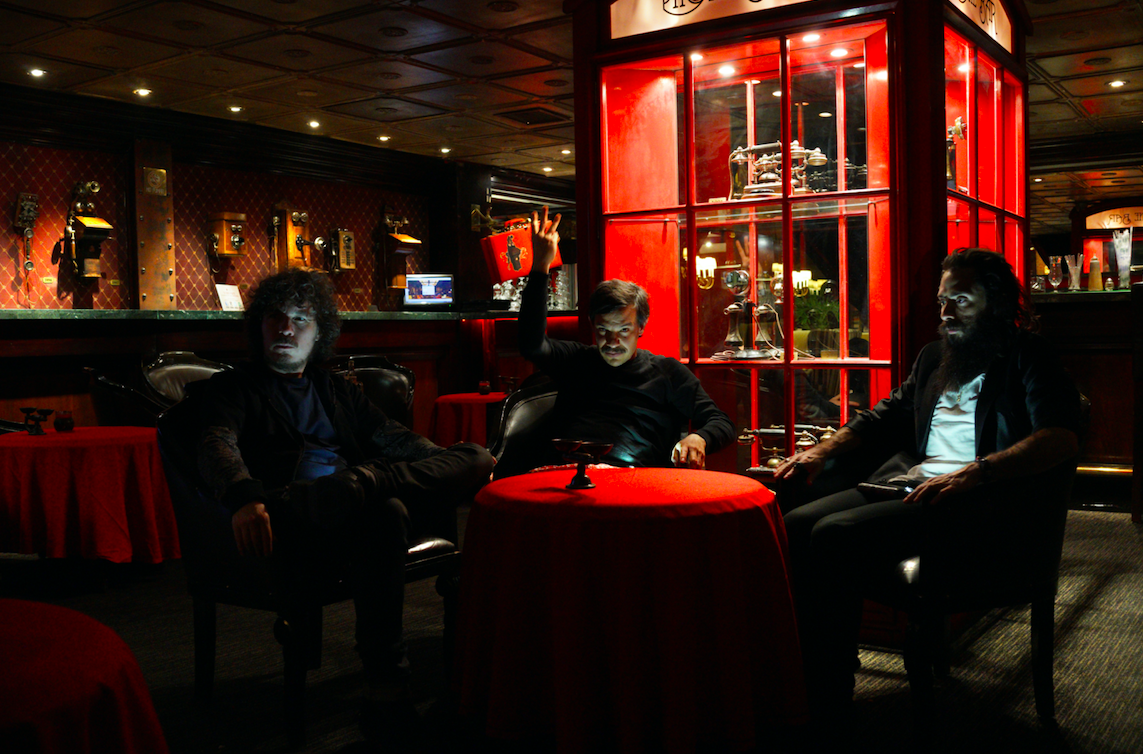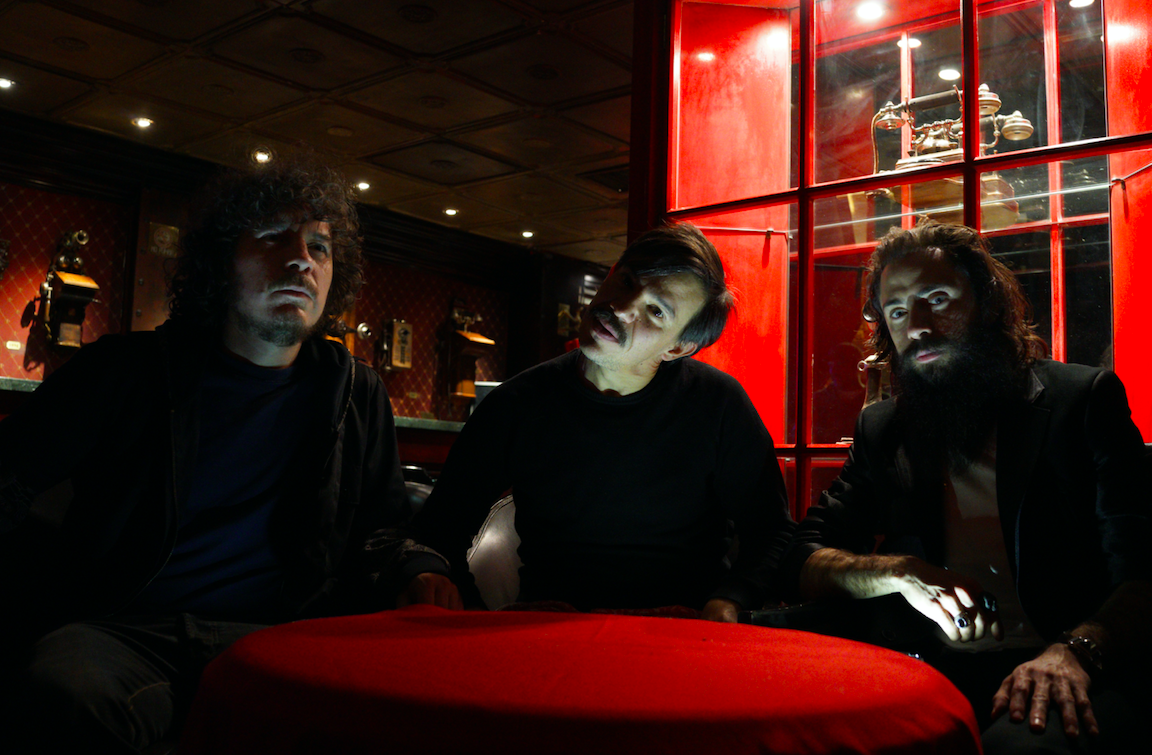Of all the music that came out of Mexico’s fertile music industry in the late 90s, electroclash legends Titán always stood out. The trio’s kitschy mix of hard line electronics, slacker aesthetics, and pop experimentation appealed to kids weaned on Beck, but were too burnt out on rock en tu idioma. Titán spoke to a generation that was thirsty for artists with similar sensibilities (like Plastilina Mosh) to emerge on the scene.
Emilio Acevedo, Julián Lede, and Jay De La Cueva joined forces in 1992, when Acevedo and Lede’s industrial group Melamina Ponderosa disbanded. Though it was poorly distributed at the time, the trio’s debut Terrordisco generated unprecedented international buzz, when even established bands couldn’t break outside of the Latin American and Spanish markets. The L.A. label Emperor Norton put out their next release, the single “C’mon Feel The Noise,” and next came along massive single “Corazón” and era-defining album Elevator, released by the Beastie Boys’ Grand Royal and Virgin Records, respectively. Titán’s videos were in constant rotation on TV, and the success garnered the band international press and a European tour.

It took six years for the follow up to Elevator to emerge. Simply titled Titán, cult electroclash label Nuevos Ricos released the record in 2005. In between albums, the trio took up side projects such as Moderatto, María Daniela y su Sonido Lasser and Silverio that introduced them to new audiences. It seemed like the world had caught up with the band; mashups were all the rage back then, and semi-ironic movements like electroclash were the bread and butter of the blogosphere.
“Whatever we do, we’re reflecting what’s happening in Mexico and the world.”
It’s been 22 years since the release of Terrordisco and 11 since their last album, but the trio is in fine form. 2016 comeback Dama features some of their darkest music to date, all without sacrificing their core sound. For this round, the trio enlisted the help of producer Nick Launay (Nick Cave, PIL, Arcade Fire) and tapped a jaw-dropping list of collaborators: Gary Numan, Egyptian Lover, and former Bananarama member Siobhan Fahey, among others. Their singles “Dama Fina” and “Dark Rain” have already made a splash, right as they set out on their tour and festival appearances with two dates in the U.S.A. We caught up with Emilio Acevedo to get an inside look at Dama and the group’s return to the stage.
How did you approach working together again? Especially since you put out Dama by yourselves?
Very well. We don’t have a set plan, but that’s the advantage of not having a label pressuring you to recoup their investment money. I mean, to make this record, we invested a lot of our own money and time.
You’ve had a rough history with labels. Can’t blame you for putting this one out on your own label.
Yeah. Our first label, BMG…actually we were lucky to sever ties with them without trouble. Our contract was originally for something like 20 years, but when we asked them about leaving they broke the contract without a problem. With EMI we had a good relationship but then we decided to do it ourselves when we released “the skull album” [2005’s Titán] through Julian’s label. Ever since we have been working with our own labels.
It allows you to work on your own terms. You even had the chance to make the album at [Texan studio] Sonic Ranch.
We invested capital to make the record how we wanted – in the best places with the best gear, the best team, the people we would love to work with. We looked for somebody we admired, and it was great that Nick Launay [agreed to produce for us]. He has worked with Public Image Ltd, Nick Cave, INXS – bands that we truly loved. It’s great that he accepted our invitation and he fell in love with the project…It’s mostly thanks to him that we got our collaborations on the record.
When you got back together and decided to make a new record, how did you set up to work? I read that you tried to approach everything differently from your previous projects.
It was a long way. Before that, we worked on another album where we worked on many ideas [but abandoned it]. We like those ideas, but we felt those songs were very similar to the “skull album.” With Titán, the number one requirement for the project is that it shouldn’t sound like anything else, including our own music. It’s a difficult premise, but the satisfaction of achieving this is much bigger in the end.
“The no. 1 requirement for the project is that it shouldn’t sound like anything else, including our own music.”
When did you decide to book a big studio?
The first album where we feel Titán took form, Elevator, was made with many producers. The lo-fi wave was still a thing, so if there was a bit of noise present, that was fine. We produced [the “skull album”] ourselves and had help from Martin Thulin for mixing. That was not a lo-fi record; we were happy to contribute “space blues” to the world [chuckles]. I’m sure there are a lot of space blues bands in the world, but never like that album. For this record, we arranged our writing a bit so that no matter how we approached it, it would sound new. Working in a super professional studio with the best guitars, amps, and mixing board made it completely different from the other albums. We began in my studio working on ideas and some ended up on the record.

Dama sounds like a darker version of Titán. What inspired this sound?
Whatever we do, we’re reflecting what’s happening in Mexico and the world. We didn’t plan it and it actually surprised me. My friends told me, “What the fuck’s up with this album? It’s so dark. It scared me; it gave me goosebumps. It sounds like the apocalypse.” It wasn’t until other people listened to it that we noticed it was a bit goth, but it wasn’t like we pushed that sound.
Now that you have played the album and are incorporating your old songs into your setlists, how do you think your catalog holds up in the live context? How do you make sense of all the different sounds you’ve done?
It was a challenge to play all the songs from the new album. We wanted to bring in more musicians, but now we stripped it down to the three of us plus a drummer, our “dama fina.” As for the old songs, they sounded alright, but when played side by side with the new ones, we had to make some rearrangements – new versions and mixes. Like “Corazón,” we weren’t feeling it live; it was sort of our penitence, a rock we had to carry. We tried some different versions of it and the one we’re doing right now, we all agree is the best version we have ever done of the song. After so many years with all our projects, we know what we want from the live show.
Titán’s Dama is out now on ATP Recordings in the US. Catch them on their upcoming US tour dates in Los Angeles and Chicago’s Ruido Fest on July 6 and 7.







